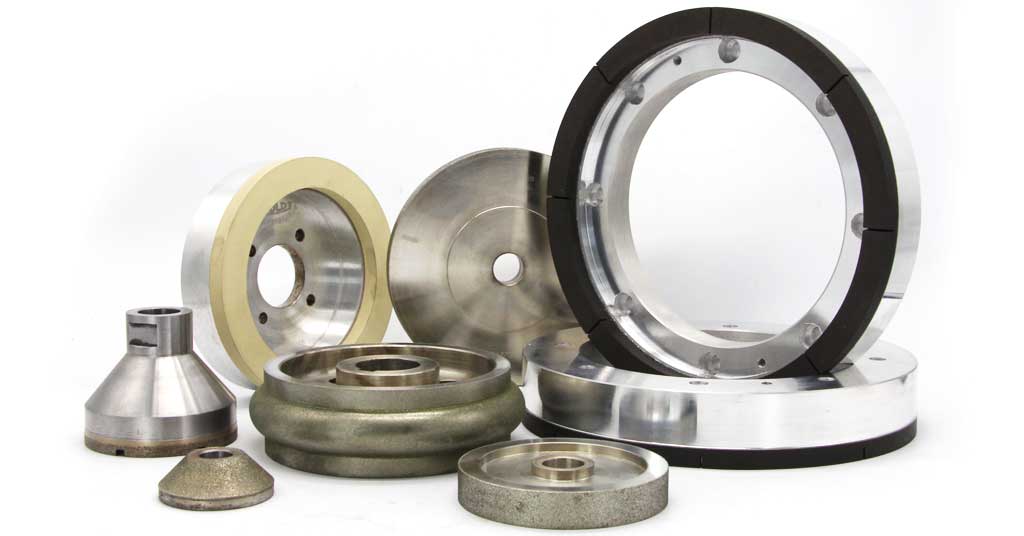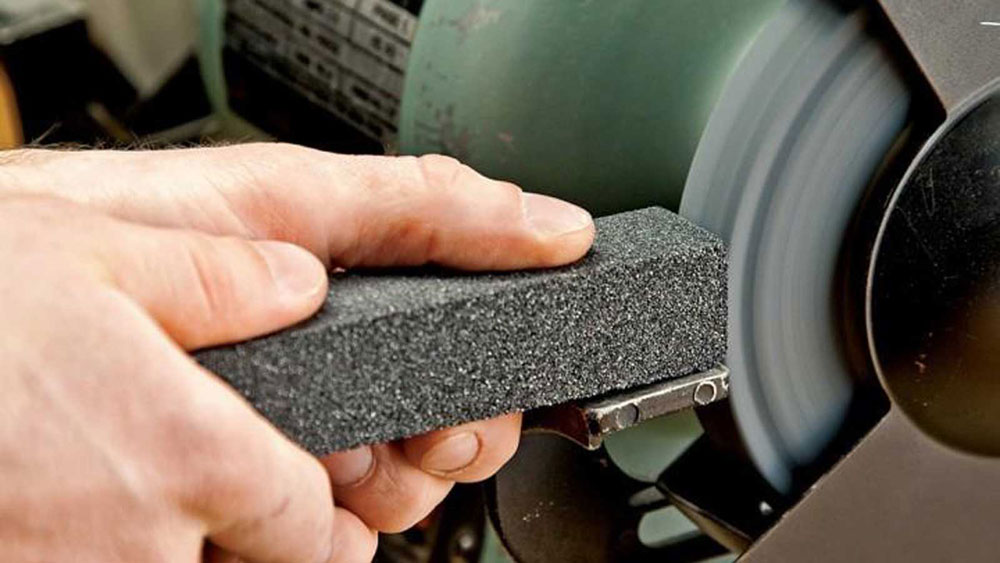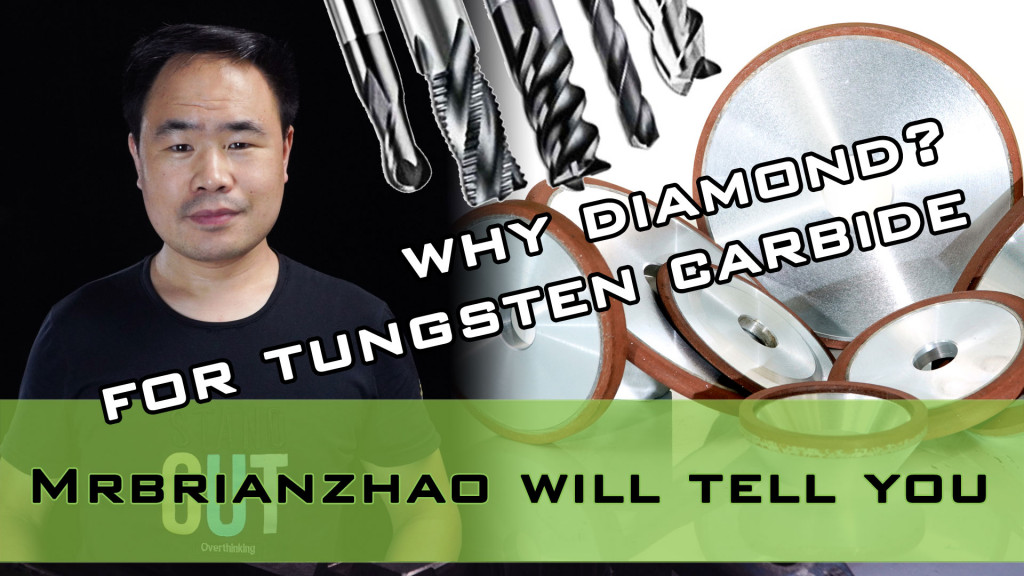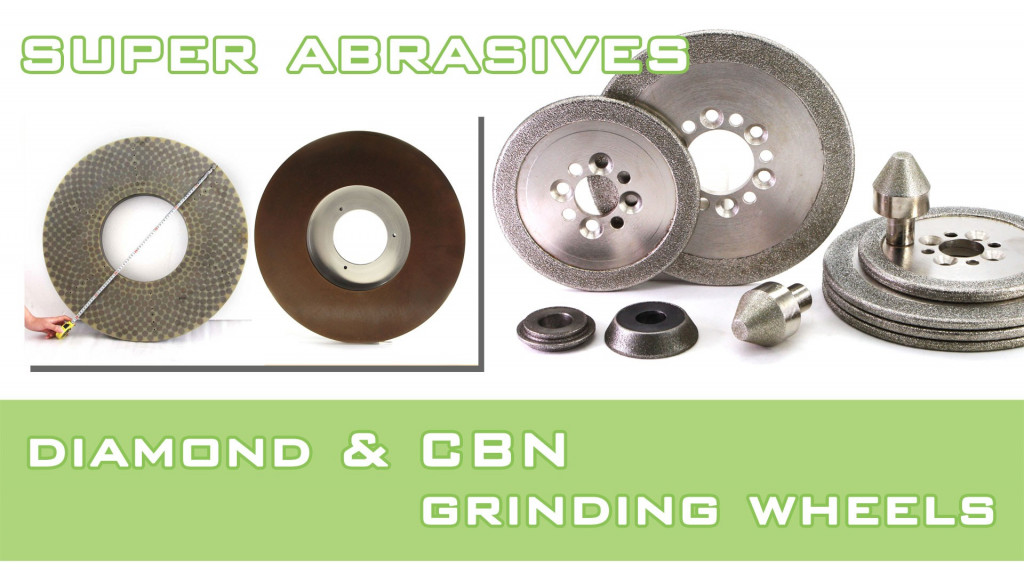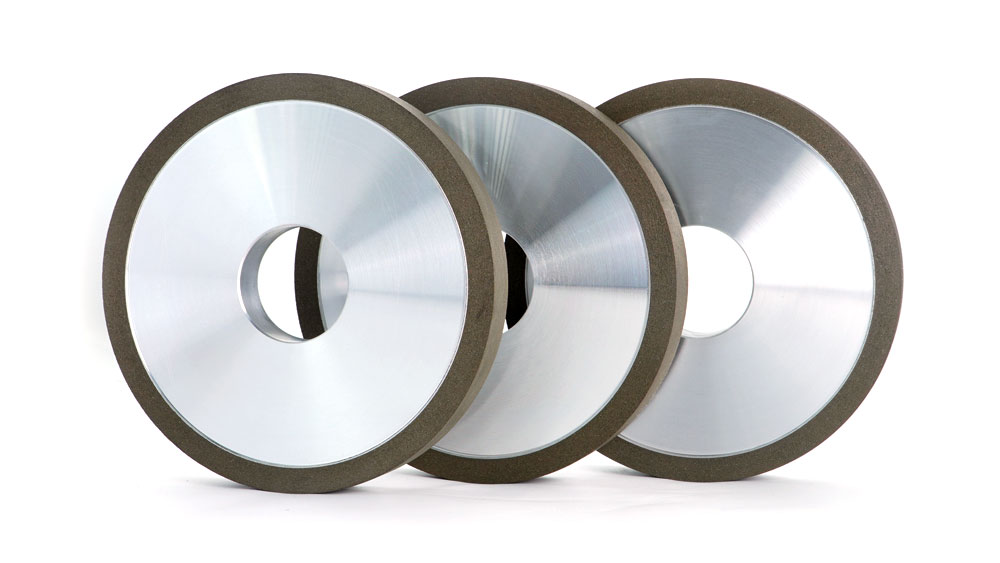A Diamond grinding wheel is a fairly new product among grinding wheels as it was first manufactured only after the discovery of synthetic materials. Research that went into synthetic materials led to the production of synthetic diamonds as well as the discovery of cubic boron nitride or CBN. Synthetic diamonds are one of the hardest materials, as of date, used for manufacturing grinding wheels. Synthetic diamonds have nickel and copper coating which ensures that they last longer. Diamond grinding wheels, made of synthetic diamonds, are therefore immensely durable and that is why they have come to be known as super abrasives.
Diamond grinding wheels structure
Diamond grinding wheels have numerous shapes like flat disks, cups, cylinders, cones, and wheels with profiles cut into their periphery etc. Diamond as also CBN grinding wheels are usually classified by shape, their grit size, the concentration and bond. Grit size of the abrasive for the diamond grinding wheels is selected based on the hardness of the cutting material.
Grit sizes between 120 and 180 are used when the grinding wheel is made for use in tool room applications. The finer grits (220 or more) are usually made on special order for use in very fine and high-quality surface finishes. The concentration of the abrasives depends for what application the wheel is being made for. The concentration of diamonds in the grinding rim depends on the application. For stock removal of tungsten carbide or hardened steel, a concentration of 75 to 125 is selected but a concentration of 150 is selected if the contact surface of the grinding wheel to the material is very small.
Another important aspect in manufacturing a diamond grinding wheel is the bond that is used to keep the abrasive grains together. Bonds used in grinding wheels have been refined over the years and the main bond options today are metal bond, resin bond, vitrified bond and electroplated with resin being the most common. Vitrified and metal bonds are generally more costly and are usually custom ordered. Electroplated wheels are commonly used in cut off wheels and for low abrasive grinding like plastics. Diamond grinding wheels have a particular marking which helps to identify them. D1A1-150R100-B4: where D1A1 stands for the wheel shape, 150 for grit size, 100 is the concentration and B4 is the bond of the manufacturer.
Diamond grinding wheel and its types
Diamond grinding wheel manufacturers assign the extent of hardness in a wheel. This is achieved by either allowing the abrasive grains to fracture easily or by restricting the fracture. When abrasives fracture easily the wheel is classified as a soft bond. Hard bond wheels can withstand larger forces since the fracturing is restricted. Soft wheels are normally used for surfaces that are easy to cut and usually have a shorter life. Hard wheels last longer and are used for finer surface finishes.
Diamond grinding wheel structure is the spacing of the abrasive grains. In an open structure wheel, there will be fewer grains that in and closed structure. The numbers 1 to 15 designate the wheel structure where the higher number stands for open structure. Diamonds represent hardness of nine and ten. If the number is lower, the wheel structure will be denser. An abrasive is chosen keeping in mind the substance that needs to be shaped. A good abrasive will keep the sharp edge and cut in clean, sharp lines. So a well- structured diamond grinding wheel should be able to sharpen itself while it is in the process of shaping another material.
Another area that requires attention when manufacturing a diamond grinding wheel is friability. Abrasives are selected depending on their friability and the nature of the material that needs to be ground. Diamond may be the hardest material but it reacts with steel when cutting. Diamond grinding wheels are manufactured differently for different industrial uses. Grinding wheels made for tungsten electrode grinders need to be industrial grade, high performing grinding wheels so that they can be used even in the most demanding jobs. They are manufactured both as handheld and bench top tungsten sharpeners for tungsten electrode which is usually heavy duty application. While silicon carbide grinding wheels could be used to rough grind tungsten carbide, only a diamond grinding wheel is the best for finish grinding.
For lapidary diamond grinding wheels, the highest quality diamonds are used so that they can provide a longer grinding life and faster cutting that is totally clean. The industrial diamonds are bonded to the edge to give the desired results when working with gemstones. The wheels can be made with plastic or steel centres though the plastic cores are better for the machine bearings. These grinding wheels are normally used for pre-forming either stone or glass roughly and have a longer grinding life.
Carbide has various grades and some can affect the diamond grinding wheel especially if there is more cobalt content in the carbide. The softer the carbide grade the more wear and tear it will cause to the grinding wheel. For an effective performance for carbide, the diamond grinding wheel should have a higher concentration and wheels with low concentrations of diamonds should not be used on carbide. Sometimes to save the grinding wheel it is more important to first rough grind the material and then use a 400 or 500 size fine grit wheel to finish it. For carbides there is nothing better than diamond grinding wheels that are of good grit size and concentration as diamond grinding wheels offer superior quality of grinding and the investment will more than makeup in terms of performance and durability.
Diamond grinding wheels are not suitable for grinding steel because steel wears away the grinding wheel when it comes into contact with it during high speed grinding. Strictly speaking diamond wheels are used on carbides and the CBN wheels are used on steel. However, sometimes there is a need to grind steel and carbide at the same time and some manufacturers make a hybrid grinding wheel with a special grit for this kind of work. Diamond wheels that are plated are used to cut non-metals like plastic, fibreglass, rubber, nylon and other synthetic material.
Diamond grinding wheels application
Diamond grinding wheels have commercial grade synthetic diamonds in them with carbides and ceramics. Natural diamonds are a form of carbon and are very expensive. However, sometimes they are used to grind very hard materials cemented carbides, marble, granite and stone. Natural diamonds are also used in diamond-tipped drill bits and saw blades for cutting or shaping rock, concrete, grinding wheels, glass, quartz and other gems, and high-speed tool steels. Diamond abrasives provide precision that is needed to finish harder surfaces. Materials like ceramics are difficult to shape and finish unless precision grinding wheels are used on them. A lot of manufacturers use diamond grinding machines as they can be employed to efficiently shape and finish metals and other materials used in the manufacture of parts in various industries. They are used in the automobile industry to make bearings and for making camshafts and rotors for jet engines. Diamond grinding wheels, as well as CBN wheels, are used to make ceramic and metallic medical and dental products. This is possible with controlled grinding and maintaining surface integrity that these grinding wheels provide. Surgical tools and dental implants as also prosthetics are made with the help of these wheels. Since diamond grinding wheels are a good way to finish asymmetrical shapes and surfaces they are used to provide the finish ceramic automotive parts. They are also used to grind aerospace and flight control components that need super precise tolerance. Even super ceramic pumps seals for Space Shuttles are made with custom made diamond grinding wheels.
How to use diamond grinding wheels for best results
Diamond grinding wheels can be expensive so all users need to be sure how to extend the life of their grinding wheels. There are a number of things to do which make it easy to extend the life of the wheels and they will also be able to contribute to a high material removal rate. Some factors that help to provide longevity and efficiency to the wheels are wheel speed, feed rate work speed and also coolant use.
Performance of a diamond grinding surface depends on wheel speeds. For wet surface grinding speeds of 4000 to 6000 sf/ruin (20 to 30 m/s) are ideal. If the speed goes below the 4000 sf/min then the efficiency will reduce and any speeds above 6000 sf/min will reduce wheel life. For dry tool and cutter grinding using grits size of 150 with concentrations of 75 to 100, the speed should be medium. Dry grinding gives the best performance at speeds that are between 3500 and 4500 sf/min (18 to 23 m/s). Grinding at speeds above 4500 sf/min (23rn/s) can cause damage to the diamond grinding wheel especially if coolant cannot be used. If coolant doesn’t cause damage to the work-piece material then it must be used if the dry grinding is done at high speeds. Similarly, work speeds must be such that they do not create excessive wear and tear or damage to either the wheel or the work.
Another area of use is feed rate or the depth at which the cut is made. Diamond grinding wheels can get chipped, burned or cracked. In such a condition, the wheel will not be able to either obtain the size, finish or the desired form in the work-piece. When face grinding cemented carbides, it can be especially harmful to take a heavy cut too quickly as the carbide can damage the wheel face. If grinding on the periphery, heavy cuts can cause the wheel to climb the material and cause the wheel to come out of the round and can damage the wheel. Let the size of the grit determine the depth of the cut. If feed rates are not maintained according to the manufacturer’s recommendations, then the work material can cut the diamond grids. During dry grinding for tools and cut it is better to use a resin-bonded diamond grinding wheel so lesser heat is produced. These effectively provide the necessary productivity without the use of coolant. It is better to maintain the speeds and feed rate rather than use coolant on dry grinds as the alternate heat and cold treatment can also damage the grinding wheel. In wet grinding, a steady stream of coolant is better than off and on use.
Abrasive industry and growth of diamond grinding wheels
With the development of high-speed grinding technology and ultra- precision grinding, the metal bonded grinding wheel has gained over the ceramic resin bonded wheels. Metal bonded diamond grinding wheel is manufactured according to sintering process so the super-abrasive can be fully utilised in making precision tools. Experimentation is on to use metals like bronze for sintered metal bonded grinding wheels. Metal binders have more strength and form and good thermal conductivity and so can withstand greater loads for higher production.
The demand for manufactured industrial products has driven the abrasive industry towards growth with China, Germany, and Japan being the leaders in abrasive industry. While large companies have many grinding products on their inventory the smaller companies specialise in products for particular manufacturing functions. The abrasive industry is engaged in separate types of grinding wheel manufacturing.
Diamond grinding wheels are therefore manufactured for machining short-chipping materials such as ceramic, glass, stone, carbide, concrete, hard plastic and carbide/steel composites. Zhengzhou Forture Tools Co., Ltd (www.forturetools.com) is one of the leaders in abrasive tools in China. Besides making grinding wheels for conventional uses, the company also makes grinding wheels for use in food processing, paper-making and machinery manufacturing industry. They use a technology that allows them to make high-quality super-abrasive grinding wheels and tools for a wide range of applications.

